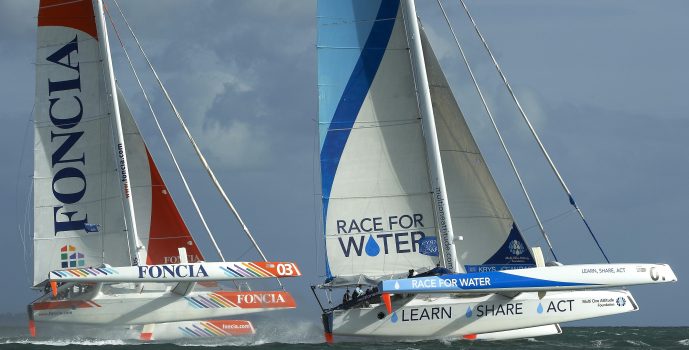3 years back, the first edition of the Volvo Ocean Race completed its first iteration on One-Design boats with a remarkable reliability record. Aside from one human error in the Indian Ocean, which resulted in the loss of a vessel, a mast break was the only serious issue to report. By contrast, the previous two editions were raced on prototypes and plagued with dramatic breakages and reliability issues…
The case for One-Design is primarily built on two core principles: firstly it is about ensuring cost control for sponsors and secondly, it is about creating a level playing field for sailing teams. Indeed, the tremendous boost in performance which we have witnessed over the past two decades, in mono-hulls and multihulls alike, has been spurred by a wave of innovations such as canting keels or foils to name only two out of many. However, with no foreseeable step change in design, creativity has given way to a phase of optimisation, where marginal performance gains are reached at an exponential cost in R&D, typically involving water tank testing, computer aided design (CAD) and increasingly expensive materials.
All those micro changes are hardly noticeable to a wider audience and of little interest outside our inner circle. As an illustration, we could look at what happened within ORMA with the arrival of Groupama 2 in 2004, which benefited from an unprecedented amount of investment, killing the competition and, some might argue, contributing to the decline of the class three years later.
The case for a one-design approach to the Ocean Masters is likely to resurface at the end of this Vendée Globe. Despite some commendable efforts from the class to address cost control and its longer-term sustainability by tweaking its rules, the outcome is less than obvious. Constraining IMOCA prototypes by, for instance standardising the rigs or swing keel sets has not for what we gather, lowered the cost of entry for new builds, as the overall budgets of the leading teams remained relatively stable. Effectively ghis has meant that the same amount of cash has been invested in areas still offering slack for innovation, such as the lifting foils. With this in mind, defending the case for One-Design through the sole prism of cost control therefore seems hard to challenge.
Yet, no matter how important—and sometimes it is indeed a show stopper—cost is only one of the elements affecting the return expected by a sponsor and there are still strong arguments in favour of box rules.
Firstly, initiating a sailing programme with a design and build phase gives a sponsor the opportunity to start telling a compelling story a lot sooner. By doing so, and by engaging with internal staff and partners over time, the sponsor takes an incremental approach to communication, reducing the risk of the investment by spreading its value outside races, and thus by better managing the inevitable uncertainties of sporting results. In other terms, the evolution of the craft becomes a full part of ‘the story’, something of particular value to sponsors which put a strong emphasis on innovation and technology in their communication strategies.
Secondly, the relative diversity of sailing styles in classes such as IMOCA allows an equally diverse range of physiques and characters to express themselves whilst remaining competitive. Some sailors may be more suitable to a light all round boat, others to a more powerful, reaching beast.
Last but not least, the sustainability argument does not necessarily dismiss box rules either. In this year’s Vendée Globe, the two thirds of the fleet is made up of second or third generation boats. Some of these, like PRB or SMA, now out the race for gear failure, were serious contenders for a podium. Second hand boats give sponsors new to the sport the opportunity to step into the circuit, at a fraction of the cost compared to winning projects.
One final point that can weigh in favour of classes based on box rules is that they have at their core the potential of scaling to a large fleet in a relatively short period of time. By multiplying the conversations between stakeholders such as sailors, design teams and shipyards, all competing for their interpretation of the rule and their slice of the pie, box rules create an open market and a dynamic for growth of the class, at least for its potential.
By contrast a One-Design class effectively concentrates interests within a monopoly. From a sponsor’s standpoint this is not necessarily an issue and can even be an asset. Rarity indeed, can be valued as too big a class carries the potential risk of diluting a team’s sponsor media exposure. Besides, whilst innovation is highly consensual as a corporate value, the R&D effort that comes with box rules can come across as a bit of a burden for sponsors whose competitive advantage does not remotely relate to the technical and process skills involved in setting up a successful campaign.
As a conclusion, both options have their upsides and downsides. With the two most prestigious ocean racing properties, namely the Volvo Ocean Race and the Vendée Globe, going down different routes on the matter… (To be continued)


